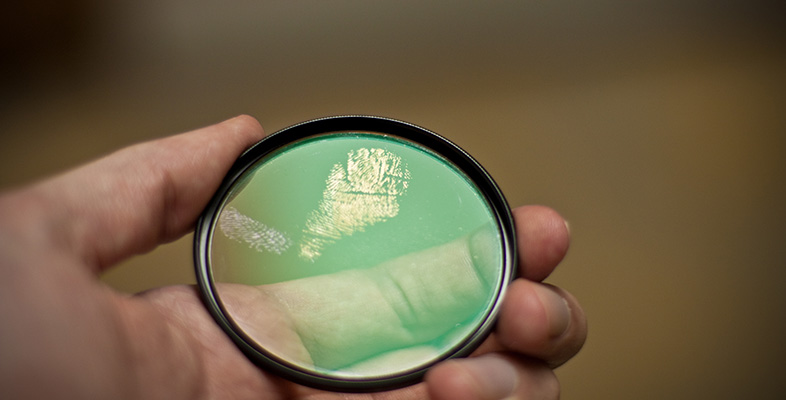2.3 Context and potential error in fingerprint analysis
There have been a number of research articles that reveal the potential for personal error in the decisions of fingerprint experts. For example, in 2006 researchers in the School of Psychology at the University of Southampton published a paper in the peer-reviewed journal Forensic Science International, in which they presented some fingerprints to experts and asked them to confirm that they did not match a set of reference fingerprints. What the experts were not told was that the prints they were given had previously been positively identified as a match with the reference prints by the experts themselves. In the experiment carried out by the Southampton psychologists, the experts were much less certain of their attributions and most of them contradicted their own previous judgements. The authors of the paper concluded that the context of the examination of fingerprints is important in affecting their judgement.
Although the Southampton study was a small-scale one, it illustrates that a process dependent on individual judgement is always going to be subject to some degree of human error. The aim is always to minimise that error and one method is to use other experts to validate the first expert's opinion. The Shirley McKie case (Case Study 1) shows that this is not always foolproof. Although that case is unusual, it is exceptions such as this that help to establish the scientific credibility of fingerprint analysis, since learning from errors helps to improve the system. The likelihood of making matches in an unambiguous way is therefore enhanced.
There are people who say that fingerprint matching, when carried out by an expert, is not an example of a scientific method because it is dependent on personal judgement and is based on an assertion that fingerprints are unique that is not subject to the scientific standards of falsifiability. When the matching is completely automated and complex mathematical formulas are used to make the comparison, matching may be accepted by critics as a science. At present the distinction between science and a highly skilled art is of academic interest, but is not likely to challenge the use of fingerprint matching in court or to undermine its usefulness.
Now read Case Study 2 relating to mistaken identification of fingerprints found in connection with the Madrid bombings in 2004.
Case study 2 The Madrid bombings and the mistaken identification of Brandon Mayfield
On 11 March 2004 a series of bombs devastated Madrid, Spain, killing 191 people and wounding 2050. The bombings were widely assumed to be inspired by Al Qaeda but there appears to have been the involvement of several disparate groups and individuals. The trial of 28 accused ran from February to July 2007. At the end of October 2007, the Audiencia Nacional de España delivered its verdicts. Of the 28 defendants in the trial, 21 were found guilty on a range of charges from forgery to murder.
In the early stages of the investigation a blue plastic bag containing detonators was found near the scene of the bombings at a railway station. A print was taken from the bag and the FBI in the USA was sent a digital copy of the print. An American lawyer Brandon Mayfield, who had converted to Islam, was identified by the FBI as a match to the fingerprint. Mayfield was never charged with a crime but was arrested by the US authorities as a material witness with possible information about the Madrid bombing.
Court records reveal the process that led to Mayfield's arrest in May 2004 and his two-week detention in the Multnomah County Jail in Oregon, USA. According to the record, Mayfield's prints were among the best 15 matches found by the FBI fingerprint computer, which holds the prints of some 45 million persons. Those matches were then compared by FBI examiners to the digital image of the partial print sent by the Spanish authorities, who finding 15 matching characteristics concluded that the print was 'a 100 per cent identification' with Mayfield (Figure 3).
Even as the FBI homed in on Mayfield, Spanish authorities were disputing the FBI's fingerprint analysis on the Madrid bag and the identification was not accepted in Spain. An independent fingerprint expert brought in by the FBI appeared, according to the court records, to confirm the FBI's attribution of the print to Mayfield. But Mayfield's lawyer said the expert's report had cautions that were not included in the FBI's affidavit (a sworn statement of evidence or fact that can be used in court without the author necessarily being present).
Although not included in the FBI's affidavit the expert's report included concerns that the quality of the print copy that was received from Spain was poor and that the image possibly included an overlay of another print. The expert said that it was important to see the original image to make a definitive identification.

It was soon recognised that an error had been made and Mayfield was released. The US attorney said the error was regrettable but that as soon as the misidentification came to light, federal authorities 'moved immediately' to have Mayfield released. The US Inspector General's Office (an office within the Department of Justice that can investigate waste, fraud and abuse within the US justice system) released a 273-page report in 2006 on the Mayfield affair. The report acknowledges that there was an 'unusual similarity' between the fingerprints, confusing three FBI examiners and a court-appointed expert. But the report also concluded that FBI examiners failed to adhere to the bureau's own rules for identifying latent fingerprints and that the FBI's 'overconfidence' in its own skills prevented it from taking the Spanish police seriously.
The errors in this case appear to have come from the use of a substandard image combined with elements of human error.
